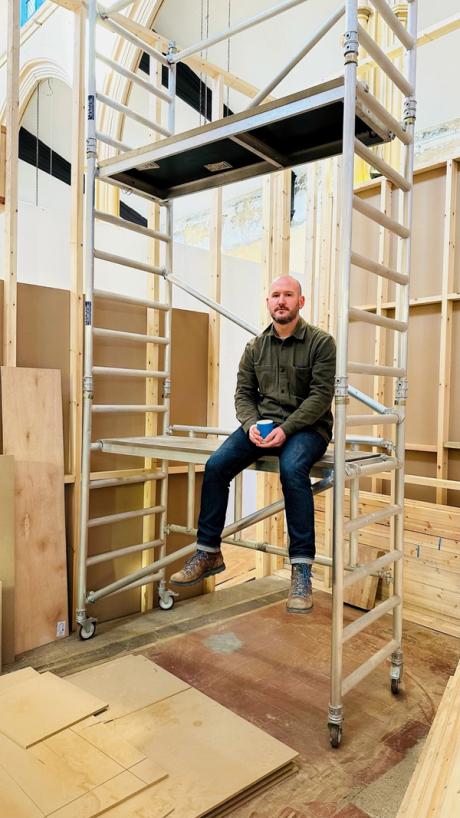
Financial and political headwinds could also be buffeting the worldwide artwork market, however a number of rising and mid-sized galleries in London are adapting by increasing and opening bigger areas.
Some galleries, like Castor Gallery, are taking a lone-wolf method. The gallery’s founder, Andy Wicks, is relocating from a rising heart in Fitzrovia to a Grade II listed church in Angel, north London, an space that isn’t Well-known for its galleries. “I believe Castel is more and more turning into a vacation spot gallery, a singular area that is not like something you will discover in a historic a part of London,” Weeks stated, noting that the market “is dealing with challenges in the intervening time,” As a result of it’s adapting to the financial slowdown. gross sales quantity. “Flexibility is necessary,” he added.
Holy Trinity Church was leased to Wickes by the Diocese of London and was constructed between 1827-29 to a design by Charles Barry, chief architect of the Homes of Parliament. “Creating a brand new gallery area in such a historic constructing and neighborhood is a uncommon alternative,” stated Weeks. The transfer expanded the exhibition area, unfold throughout two purpose-built galleries and places of work.
The brand new gallery will launch in April and host its first solo exhibition in London, burning idols, created by Fabian Ramírez, a Mexican artist based mostly in London. Works vary in value from £2,000 to £15,000, with one altarpiece promoting for £30,000. Along with the exhibition programme, Weeks plans to host a rotating collection of outside sculptures within the backyard resulting in the gallery entrance.
Relocation is nothing new for sellers. Wicks first established his gallery in Deptford in 2016 and has upgraded a number of occasions to bigger areas round south London. In 2022 he moved to the dearer Fitzrovia, the place he has shared an area with Indigo + Madder for the previous 18 months (their lease doesn’t expire till Could, future plans might be shared in the end).
Galleries corresponding to Pipeline Up to date and PM/AM have flocked to Fitzrovia previously two years, becoming a member of the likes of Edel Assanti, Alice Black, Vitrine, Brooke Bennington and Office Gallery.
Niru Ratnam, who has owned a gallery in Soho since 2020, is the most recent addition to central London’s city scene, which is conveniently near Mayfair and provides inexpensive lease. “It’s turning into more and more clear that gallery-goers do prefer to congregate in teams,” Ratnam stated, including that the transfer to Fitzrovia supplied the chance to determine coveted ground-floor galleries. The brand new venue additionally has a basement that serves as one other exhibition area and viewing room, which can permit the gallery to showcase new artists alongside its current 11 artists. The brand new gallery opens subsequent week with an exhibition of work by Emma Cousin (£8,000-£14,000, works on paper £2,000).
Ratnam acknowledged that the transfer “could appear a bit counterintuitive” in a market that’s “undoubtedly tougher.” He added: “The saying ‘Both proceed to evolve or develop’ could be very apt – when you keep the identical, you’ll undoubtedly run the danger of being steadily overwhelmed by the rising challenges available in the market.” In the end, having extra space and it The elevated visibility permits artists to conceive extra formidable exhibitions. As Ratnam places it: “Institutional recognition is a key method to deal with the market calm, and having the ability to present artists with an area to assume ambitiously is especially related now.”
The vendor plans to avoid wasting prices in different areas, corresponding to limiting the variety of artwork gala’s held every year. “Artwork gala’s are nonetheless one of the best ways to satisfy new collectors, however they don’t make a gallery of our dimension a ton of cash over the course of a 12 months, so in a method they’re a little bit of a Luxurious add-ons,” Ratnam stated.
As soon as the de facto gallery capital of London, the East Finish has retained a few of its standing as a gallery centre. Emalin, which launched in late 2016, this week opened a second gallery area in Clerk’s Home, Shoreditch’s oldest constructing. Angelina Volk and Leopold Thun, the gallery’s founders, stated: “There isn’t any doubt that the financial setting is now extra advanced than after the outbreak, however coping with this period One of the best ways is to spend money on a stable basis.”
Nonetheless, they argue that Britain’s cultural panorama appears to thrive in occasions of financial and political strife, reflecting the Thatcher years and the rise of subcultures within the Eighties. “We’ve by no means seen so many new areas open since we opened our personal gallery,” Volker and Thune stated. “It looks like your entire London cultural neighborhood is working collectively in the intervening time to push ahead by these tough occasions.”

